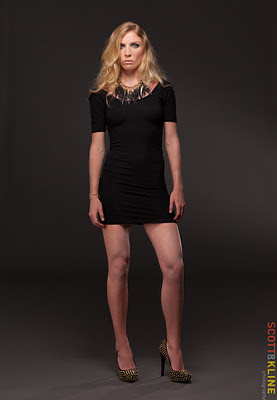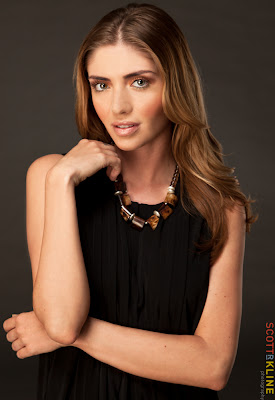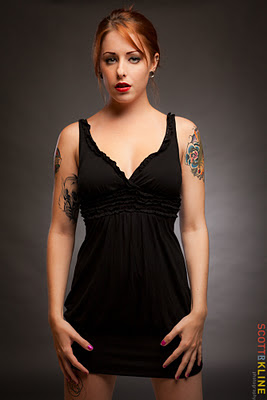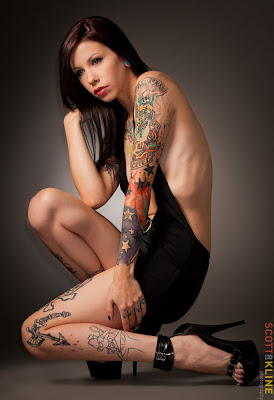 Emily in an American Apparel Dress
Emily in an American Apparel DressI recently shot a whole series of shots with the models appearing in their favorite Little Black Dress, or LBD, as it will be abbreviated here. I also decided to shoot on a black or dark grey background, to simplify the shot and increase the emphasis on the subject. This post, like most on this blog, will discuss the technical challenges of the shoot. For more on the philosophy and concept, read the blog on my website at scottrklinephoto.com/blog.
I always like to light my subjects in studio (and usually outside) with an Octobox for the key light. I place it as close to the subject as possible, usually off to one side, but occasionally right behind me. This provides a soft flattering light on the subject. A circular catch-light is another nice aspect. (See photo below of Karli Henneman for catch light)
 Karli Henneman in LBD with Vintage Jewelry
Karli Henneman in LBD with Vintage JewelryThe challenge here, with the dark background is getting a good separation of the black dress from the background. The first thing I tried was creating a slash shaped gradient of light by throwing a strobe on the background then cutting the light in a diagonal shape using flags. (You can see this effect in the first photo of Emily above.) I found this frustrating and inconsistent, every time I got the light balanced on the subject, I has to rebalance the background. Also, unless the studio is huge and the subject is a long distance from the background, light from the Octobox spills onto the background, spoiling the dark effect. This can be mitigated to some degree by flagging the Octobox.
Later, I decided to place a snooted or gridded strobe above the model that points to the background, at waist level. I like the circular gradient I get. It generally flatters by outling the curves of the model. It also tends to be behind the black dress. The darker part of the background tends to be behind the head, arms and legs, giving a nice contrast to all aspects.
 Miss Nicole Malice in her own dress
Miss Nicole Malice in her own dressI like to throw a rim light on the opposite side from the Key Light. This is usually done with a grid or bare strobe placed behind the model and just off camera. I center it on the shoulder so that it falls on the hair and the arm as well. Occasionally, I will rim both sides for variety.
Finally, I often use a handheld speedlight, right above the lens for some fill to give the dress a little more detail. Sometime this adds a second smaller catch-light as you can see in the Karli photo.
As for camera settings, I usually shoot around 5.6. This allows me to get most of the subject in focus, and have the background somewhat out-of-focus, minimizing and flaws in the seamless.
I think this set up is very dramatic and flattering. It also has the simplicity that mirrors the dress.
 Krysta Kaos in her own LBD and shoes
Krysta Kaos in her own LBD and shoesYou can see the entire collection of black dress shots on my flickr page.






























